Plane of the ecliptic - Study guides, Class notes & Summaries
Looking for the best study guides, study notes and summaries about Plane of the ecliptic? On this page you'll find 68 study documents about Plane of the ecliptic.
All 68 results
Sort by

-
PPL NAVIGATION REAL EXAM 330 QUESTIONS AND CORRECT ANSWERS 2024-2025 LATEST ALREADY GRADED A+ An observer is located north of the plane of the ecliptic
- Exam (elaborations) • 64 pages • 2024
-
- $20.49
- + learn more
PPL NAVIGATION REAL EXAM 330 QUESTIONS AND CORRECT ANSWERS LATEST ALREADY GRADED A+ An observer is located north of the plane of the ecliptic PPL NAVIGATION REAL EXAM 330 QUESTIONS AND CORRECT ANSWERS LATEST ALREADY GRADED A+ An observer is located north of the plane of the ecliptic
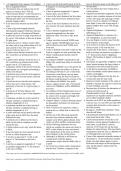
-
ASTR 114 Astronomy - Final Exam "Cheat Sheet" | Latest 2023-2024
- Exam (elaborations) • 6 pages • 2023
-
- $7.99
- 2x sold
- + learn more
-1.5 magnitude Sirius appears 25x brighter than 2 magnitude Polaris. “All neutron stars are pulsars, but not all pulsars are neutron stars” FALSE “Spectroscopic Binary” is the term given to a pair of stars that we can determine are orbiting each other only by measuring their periodic Doppler shifts. A 6.8 solar mass neutron star does NOT exist. A loop of gas and charged particles following the magnetic field lines between sunspot’s poles is a Prominence/...
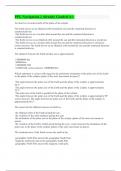
-
PPL Navigation || Already Graded A+.
- Exam (elaborations) • 42 pages • 2024
-
- $15.49
- + learn more
An observer is located north of the plane of the ecliptic The Earth moves on an elliptical orbit around the sun and the rotational direction is counterclockwise The Earth moves on a circular orbit around the sun and the rotational direction is counterclockwise The Earth moves on an elliptical orbit around the sun and the rotational direction is clockwise The Earth moves on a circular orbit around the sun and the rotational direction is clockwise correct answers The Earth moves on an ell...
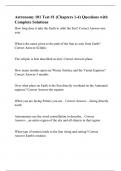
-
Astronomy 101 Test #1 (Chapters 1-4) Questions with Complete Solutions
- Exam (elaborations) • 13 pages • 2024
-
- $15.49
- + learn more
How long does it take the Earth to orbit the Sun? Correct Answer-one year What is the name given to the path of the Sun as seen from Earth? Correct Answer-Ecliptic The ecliptic is best described as a(n): Correct Answer-plane How many months apart are Winter Solstice and the Vernal Equinox? Correct Answer-3 months Over what place on Earth is the Sun directly overhead on the Autumnal equinox? Correct Answer-the equator When you are facing Polaris you are... Correct Answer-...facing ...
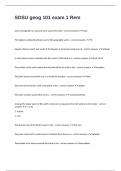
-
SDSU geog 101 exam 1 Rem 2024/2025 with 100% correct answers
- Exam (elaborations) • 19 pages • 2024
-
- $14.99
- + learn more
Lines of longitude run east and west across the earth - correct answers False The highest numbered latitude used in the geographic grid is - correct answers 90 Angular distance north and south of the Equator is measured using lines of - correct answers latitude A circle whose center coincides with the center of the Earth is a - correct answers Great Circle The portion of the earth system that includes all life on earth is the - correct answers biosphere The Earth moves around the ...

-
Oceanography: EXAM 2 || A+ Graded Already.
- Exam (elaborations) • 21 pages • 2024
-
Available in package deal
-
- $13.49
- + learn more
Angle of of Earth's Tilt on its Axis correct answers ~23.5 degrees Ecliptic correct answers the plane traced by Earth's solar orbit Earth's Seasons: explanation correct answers 1) caused by unequal distribution of solar energy across Earth's surface due to the planet's tilt and rotation on its axis the 4 "Marks" of Earth's Seasons correct answers 1) vernal equinox 2) summer solstice 3) autumnal equinox 4) winter solstice Vernal equinox correct answers 1) starts on March 21...
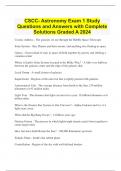
-
CSCC- Astronomy Exam 1 Study Questions and Answers with Complete Solutions Graded A 2024
- Exam (elaborations) • 15 pages • 2024
-
- $14.99
- + learn more
Cosmic Address - The galaxies we see through the Hubble Space Telescope Solar System - Sun, Planets and their moons, and anything else floating in space Galaxy - Great island of stars in space all held together by gravity and orbiting a common center Where is Earth's Solar System Located in the Milky Way? - A little over halfway between the galactic center and the edge of the galactic disk Local Group - A small cluster of galaxies Supercluster - Regions of the universe that is ti...
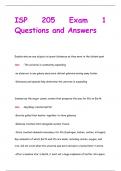
-
ISP 205 Exam 1 Questions and Answers
- Exam (elaborations) • 20 pages • 2024
- Available in package deal
-
- $12.49
- + learn more
Explain why we see objects at great distances as they were in the distant past Ans- -The universe is constantly expanding -an observer in any galaxy sees more distant galaxies moving away faster -Distances and speeds help determine the universe is expanding Summarize the major cosmic events that prepared the way for life on Earth Ans- -Big Bang created matter -Gravity pulled that matter together to form galaxies -Galaxies created stars alongside nuclear fusion -Stars created elements nec...
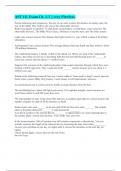
-
AST 111 Exam Ch. 1-3 || very Flawless.
- Exam (elaborations) • 7 pages • 2024
-
Available in package deal
-
- $10.99
- + learn more
Put the following into perspective: the size of our solar system; the distance to nearby stars; the size of the Milky Way Galaxy; the size of the observable universe. Rank from largest to smallest. To rank items as equivalent, overlap them. correct answers The observable universe, The Milky Way Galaxy, Distances to nearby stars, and The Solar system Light-year: correct answers The distance that light travels in 1 year, which is about 9.46 trillion kilometers. Astronomical Unit: correct an...
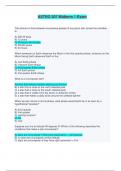
-
ASTRO 207 Midterm 1 Exam - Questions with Verified Answers
- Exam (elaborations) • 11 pages • 2024
-
- $16.99
- + learn more
ASTRO 207 Midterm 1 Exam - Questions with Verified Answers The amount of time between successive passes of any given star across the meridian is: A) 365.25 days B) 12 years C) 23 hours, 56 minutes D) 26,000 years E) 24 hours When someone on Earth observes the Moon in the first-quarter phase, someone on the Moon facing Earth observes Earth in the: A) new Earth phase B) crescent Earth phase C) third-quarter Earth phase D) full Earth phase E) first-quarter Earth phase What is a circumpolar star? ...

How much did you already spend on Stuvia? Imagine there are plenty more of you out there paying for study notes, but this time YOU are the seller. Ka-ching! Discover all about earning on Stuvia


